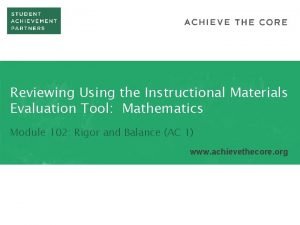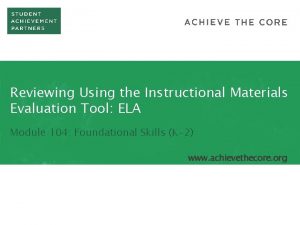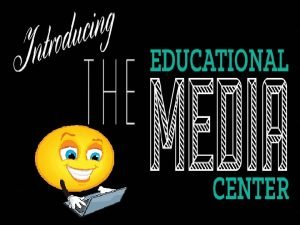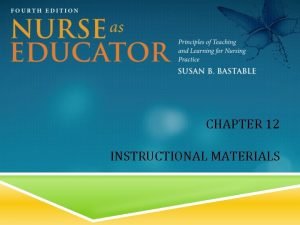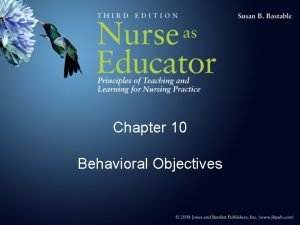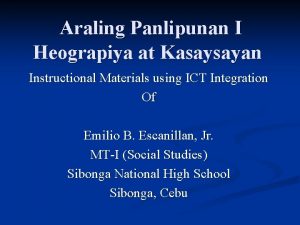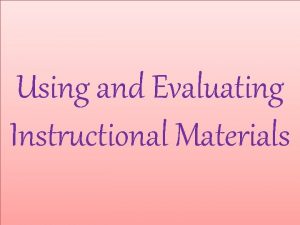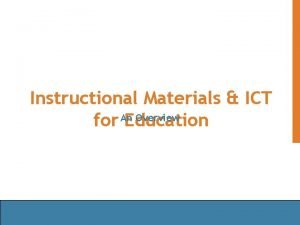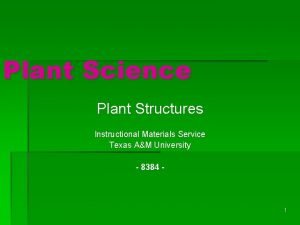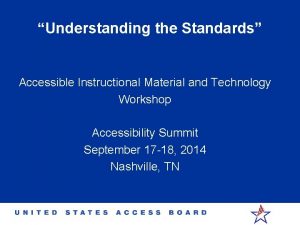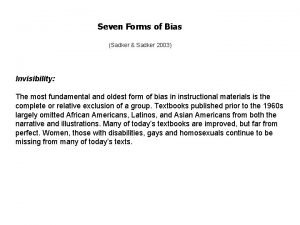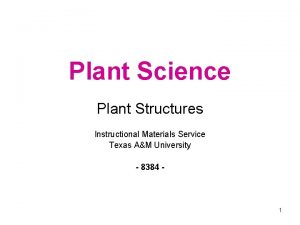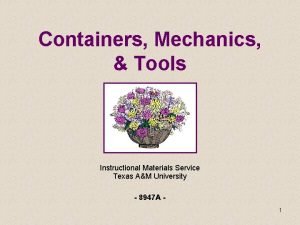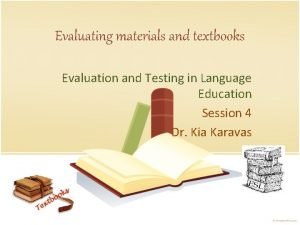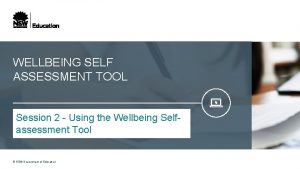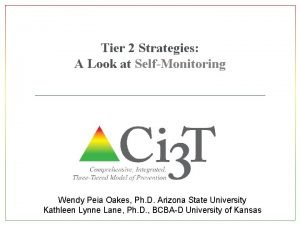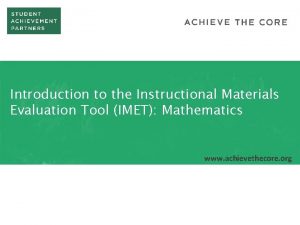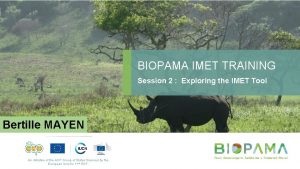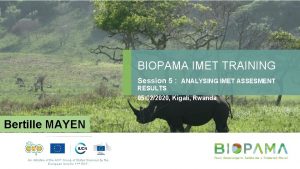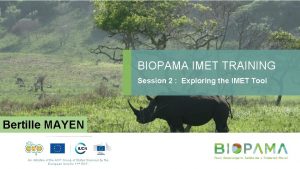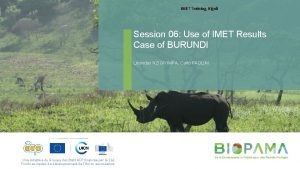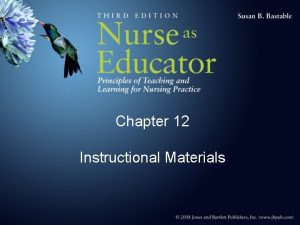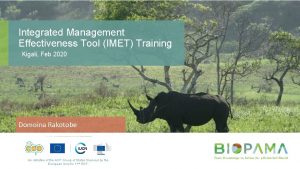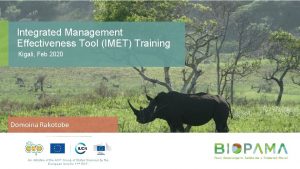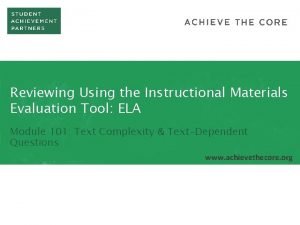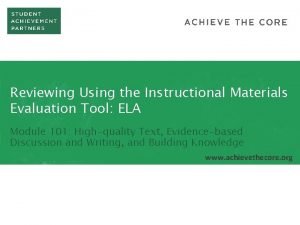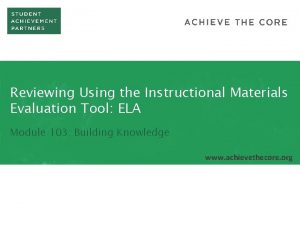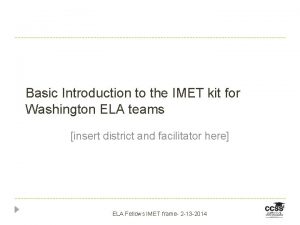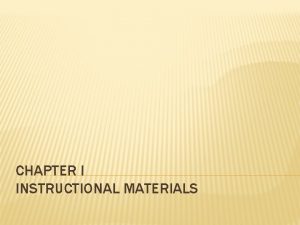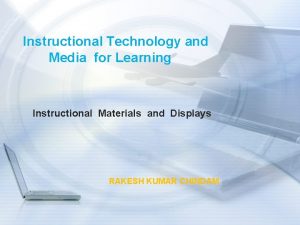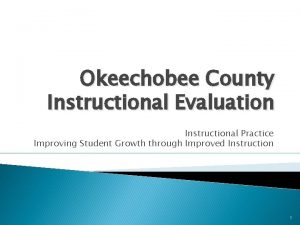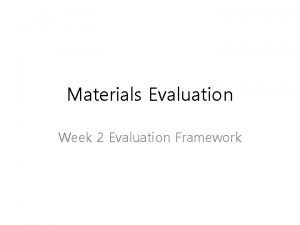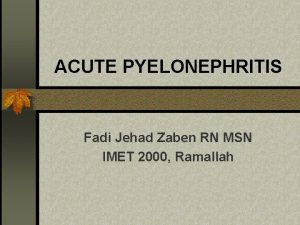Introduction to the Instructional Materials Evaluation Tool IMET



























































- Slides: 59

Introduction to the Instructional Materials Evaluation Tool (IMET): ELA www. achievethecore. org

Essential Questions • What is the Instructional Materials Evaluation Tool (IMET)? How is it structured? • How does the IMET enable reviewers to evaluate whether instructional materials are aligned to the major features of the Standards and fulfill the Shifts they require? • How could the IMET be useful in a variety of settings to bring the CCSS and Shifts to life for students? PAGE 2

Goals • Understand that the IMET is a powerful tool that enables reviewers to evaluate whether instructional materials are aligned to the Common Core State Standards • Understand how the IMET structure and levels of alignment illuminate the major features of the standards • Consider pertinent uses for the IMET including evaluating new or current curricular materials, developing materials, and professional learning PAGE 3

Agenda • • • Introduction to the IMET Review the Shifts Color the Shifts activity Non-Negotiable 1: Text Complexity Non-Negotiable 2: Text-Dependent Questions Non-Negotiable 3: Building Knowledge Non-Negotiable 4: Foundational Skills (K-2) Alignment in materials Summarizing PAGE 4

“In general, teachers are much more likely to cover topics presented in the materials selected by their school or district than to cover topics not included; they are likely to follow the sequence of topics in the selected materials; and their pedagogical approach is influenced by the instructional design of the materials. The evidence is clear that instructional interactions between students and teachers are framed by the instructional materials that are provided by their schools and districts. ” Chingos & Whitehurst, Choosing Blindly: Instructional Materials, Teacher Effectiveness, and the Common Core PAGE 5

“There is strong evidence that the choice of instructional materials has large effects on student learning – effects that rival in size those that are associated with differences in teacher effectiveness. ” Chingos & Whitehurst, Choosing Blindly: Instructional Materials, Teacher Effectiveness, and the Common Core PAGE 6

History of the IMET • • • Achieve Student Achievement Partners Council of Chief State School Officers PAGE 7

IMET Sources • Common Core State Standards for English Language Arts & Literacy in History/Social Studies, Science, and Technical Subjects • Supplement to Appendix A of the Common Core State Standards for ELA/Literacy: New Research on Text Complexity PAGE 8

When to Use the IMET • • Purchasing or evaluating new materials Evaluating materials currently in use Developing materials Professional learning PAGE 9

The IMET: An Overview • Versions for ELA/Literacy: Kindergarten– 2 nd grade, and 3 rd– 12 th grades – For Math: Kindergarten– 8 th grade, and High School • Comprehensive curricula • 2 Levels of Alignment: – Non-Negotiable (NN) Alignment Criteria – Alignment Criteria (AC) • www. achievethecore. org/imet PAGE 10

3 Shifts in ELA Regular practice with complex texts and their academic language Reading, writing, and speaking grounded in evidence from text, both literary and informational Building knowledge through content-rich non-fiction PAGE 11

Shift 1: Text Complexity ✓ HS to College Gap Regular practice with complex texts and their academic language ✓ Complexity predicts college success (ACT study) ✓ High rates of remediation ✓ CCSS staircase of complexity: ES → HS ✓ Engaging with complex language and rich vocabulary PAGE 12

Students who can read literally can read inferentially. PAGE 13

Students who can perform one strategy can perform all strategies. PAGE 14

Ability to read complex text differentiates college -ready readers. PAGE 15

Shift 2: Evidence ✓ College and workplace writing Reading, writing and speaking grounded in evidence from text, both literary and informational ✓ Major emphasis of the ELA Standards ✓ Hallmarks of strong readers and writers ✓ Equity PAGE 16

Shift 3: Knowledge ✓Large research base Building knowledge through content -rich non-fiction ✓Knowledge crucial to comprehension ✓Very little nonfiction in school ✓College & workplace focus on nonfiction ✓Informational text harder PAGE 17

Everyone knows knowledge plays a role in comprehension, but how big of a role? “The Baseball Study” Recht & Leslie (1988) PAGE 18

The Baseball Study: Recht & Leslie (1988) Compared reading comprehension for four categories of students: High reading ability, High knowledge of baseball High reading ability, Low knowledge of baseball Low reading ability, High knowledge of baseball Low reading ability, Low knowledge of baseball PAGE 19

Knowledge of the topic had a much bigger impact on comprehension than generalized reading ability did. Measure of Comprehension 100% 90% 80% 70% 60% 50% 40% 30% 20% 10% 0% high reading ability & high knowledge low reading ability & high knowledge high reading ability & low knowledge low reading ability & low knowledge PAGE 20

Activity: Color the Shifts PAGE 21

ELA Shifts 1. Regular practice with complex text and its academic language 2. Reading, writing, and speaking grounded from evidence from text, both literary and informational 3. Building knowledge through content-rich nonfiction PAGE 22

PAGE 23

The Non-Negotiable Alignment Criteria

High-Quality Text Non-Negotiable 1: Anchor texts are worthy of students’ time and attention. Texts are of quality, containing rich academic language, and are rigorous, meeting the text complexity criteria for each grade. • Metric 1 A: Anchor texts in the materials have the appropriate level of complexity for the grade as defined by the standards, according to quantitative and qualitative analysis. • Metric 1 B: Anchor texts in the materials are of publishable quality and worthy of especially careful reading; the include a mix of informational texts and literature. IMET p. 5 PAGE 25

High-Quality Text Complexity: What Is It and Why? CCSS. ELA-Literacy. CCRA. R. 10 Read and comprehend complex literary and informational texts independently and proficiently. For example, in 4 th grade: By the end of the year, read and comprehend informational texts, including history/social studies, science, and technical texts in the grades 4 -5 complexity band proficiently, with scaffolding as needed at the high end of the range. PAGE 26

High-Quality Text Analyzing Text Quality PAGE 27

High-Quality Text Quantitative Text Complexity ✓Excellent at situating informational texts ✓Good at offering a starting point for placing narrative fiction ✓Unable to rate drama and poetry ✓Not helpful for K-1 texts PAGE 28

High-Quality Text Analyzing Text Complexity: Quantitative Verify that each text has been placed within a grade band based on at least one quantitative measure. PAGE 29

High-Quality Text Quantitative Text Complexity Grapes of Wrath: Lexile Score: 680 L Grade Band Placement: 2 -3? PAGE 30

High-Quality Text Qualitative Measures Qualitative measures consider: ✓Text Structures ✓Language Features ✓Meaning/Purpose ✓Knowledge Demands PAGE 31

Tool: Analyzing Text Quality PAGE 32

High-Quality Text Reader and Task Considerations Finally, there are factors relating to your readers and the task to consider: ✓ Desired Outcomes/Understandings ✓ Complexity of Content ✓ Specific student needs ✓ Reading Skills ✓ Motivation & Engagement ✓ Prior Knowledge PAGE 33

High-Quality Text Non-Example PAGE 34

High-Quality Text Example PAGE 35

Metric 1 B: Anchor texts in the materials are of publishable quality and worthy of especially careful reading; they include a mix of informational texts and literature. • Consider: Which of these K-2 read aloud texts are worthy of careful reading? • Discuss: What would instructions supporting careful reading look like for teachers or students? What actions and directions would materials include? IMET p. 8 PAGE 36

High Quality Text Example or Non-Example? PAGE 37

Evidence-based Discussion and Writing Non-Negotiable 2: Materials provide opportunities for rich and rigorous evidence-based discussions and writing about texts to build strong literacy skills. • Metric 2 A: At least 80% of all questions, tasks, and assignments in the materials are text-dependent, requiring students to draw on textual evidence to support both what is explicit as well as valid inferences from the text. The overwhelming majority of these questions and tasks are textspecific. • Metric 2 B: Materials include frequent opportunities for evidence-based discussions and writing to support careful analyses, well-defended claims, and clear information about texts to address the analytical thinking required by the Standards at each grade level. IMET p. 9 PAGE 38

Evidence-based Discussion and Writing Considering Text Dependency • Does answering the question require that students have read the passage? • Is the question tied to a passage (not standalone)? • Does the question require students to cite or use evidence from the passage to determine the correct answer? • Does the question require students to follow the details of, make inferences from, and/or evaluate what is read? PAGE 39

Evidence-based Discussion and Writing Example or Non-Example? PAGE 40

Evidence-based Discussion and Writing Example PAGE 41

Evidence-based Discussion and Writing Practice: Text-Dependent Questions • Use the passages (Fossil Fish Found! and Earthquakes) and associated question sets to gather evidence for the NN 2 metrics. • Be prepared to share your findings. PAGE 42

Evidence-based Discussion and Writing Let’s reach consensus: • What evidence did you find where your materials were in alignment with the criterion? • What other evidence would you want to collect? PAGE 43

Building Knowledge Non-Negotiable 3: Materials build knowledge systematically through reading, writing, speaking and listening, and language study. • Metric 3 A: Materials provide a sequence or series of texts that build knowledge and vocabulary systematically through reading, writing, listening, and speaking. These texts are organized around a variety of topics at each grade level. • Metric 3 B: Materials provide instructions, clear design and lightweight student accountability, that guide instructors regarding how students will regularly engage in a volume of independent reading, both assigned, related to the anchor texts, or texts of their own choosing, in or outside of class. IMET p. 13 PAGE 44

Building Knowledge “By reading texts in history/social vocabulary systematically through reading, writing, listening, and texts are studies, science, and other organized around a variety of topics at each grade level. disciplines, students build a foundation of knowledge in these fields that will also give them the background to be better readers in all content areas. Students can only gain this foundation when the curriculum is intentionally and coherently structured to develop rich content knowledge within and across grades. ” -- CCSS Anchor Reading Standards IMET p. 14 PAGE 45

Building Knowledge IMET p. 14 PAGE 46

Building Knowledge Example PAGE 47

Building Knowledge Metric 3 B: Materials provide instructions, clear design and lightweight student accountability, that guide instructors regarding how students will regularly engage in a volume of independent reading, both assigned, related to the anchor texts, or texts of their own choosing, in or outside of class. Close reading alone is NOT enough! In fact, done alone, it can INCREASE the achievement gap. IMET p. 15 PAGE 48

Building Knowledge A volume of reading should be balanced with the close analytic reading. Close Reading Volume of Reading Fewer pages More pages Grade-level complex text Text at different levels of complexity All students same text Student or teacher choice of text Teaches students to attend to text and to words Rapidly builds knowledge & vocab Heavy support Light support Solely instructional Guided or independent Exposes students to higher level content Builds knowledge of words, and the world Gives all students access Builds love of reading PAGE 49

Building Knowledge Independent Reading PAGE 50

Foundational Skills Non-Negotiable 4: Materials develop foundational reading skills systematically, using research-based and transparent methods. This means materials provide explicit and systematic instruction and diagnostic support in: concepts of print, letter recognition, phonemic awareness, phonics, word awareness and vocabulary development, syntax, and fluency. IMET p. 17 PAGE 51

Foundational Skills NN Metric 4 A: Provides instruction in concepts of print, letter recognition, phonemic awareness, phonics, word awareness, vocabulary development, syntax, and reading fluency NN Metric 4 B: Variety of student reading material and activities that allows for frequent practice of all foundational skills. NN Metric 4 C: Provides clear, well-structured diagnostic assessment protocols and materials for all foundational skills to guide instruction and remediation. NN Metric 4 D: Materials guide students to read with purpose and understanding. NN Metric 4 E: Grade 2 materials provide opportunities for students to engage in a range and volume of reading to achieve reading fluency. IMET p. 17 PAGE 52

Literacy is… PAGE 53

Foundational Skills Practice: Foundational Skills • Consider the attached sample lesson from the Core Knowledge Skills Strand, Grade 1, through the lens of Non-Negotiable 4. What evidence for the metrics do you see? Individually write your findings on the IMET. • Then read the Louisiana Believes excerpted review of the program. What do you notice? • What other program components would you want to investigate? PAGE 54

Alignment Criteria

PAGE 56

Essential Questions • What is the Instructional Materials Evaluation Tool (IMET)? How is it structured? • How does the IMET enable reviewers to evaluate whether instructional materials are aligned to the major features of the Standards and fulfill the Shifts they require? • How could the IMET be useful in a variety of settings to bring the CCSS and Shifts to life for students? PAGE 57

Use Cases for the IMET • Evaluating current materials • Purchasing decisions • Creation of materials • Professional learning Discussion question: • How will the IMET be useful to you in your context? PAGE 58

Want to Learn More? PAGE 59
 Instructional materials evaluation tool
Instructional materials evaluation tool Evaluation tool for instructional materials
Evaluation tool for instructional materials Functions of school multimedia centre
Functions of school multimedia centre Visual instructional materials
Visual instructional materials Instructional materials examples
Instructional materials examples Disadvantages of behavioral objectives
Disadvantages of behavioral objectives Heograpiya meaning araling panlipunan
Heograpiya meaning araling panlipunan Hayden smith and thomas nagel
Hayden smith and thomas nagel Instructional materials in ict
Instructional materials in ict Instructional materials service
Instructional materials service Examples of accessible instructional materials
Examples of accessible instructional materials Cosmetic bias
Cosmetic bias Parts of flower
Parts of flower Health education plan
Health education plan Instructional materials service
Instructional materials service Steps of textbook evaluation
Steps of textbook evaluation Natural materials and man made materials
Natural materials and man made materials Useful materials at home and ways to use
Useful materials at home and ways to use Man made map
Man made map Adopting and adapting teaching materials
Adopting and adapting teaching materials Direct materials budget with multiple materials
Direct materials budget with multiple materials Wellbeing framework self-assessment tool
Wellbeing framework self-assessment tool Monitoring and evaluation tool sample deped
Monitoring and evaluation tool sample deped Annual implementation plan
Annual implementation plan Cutting workshop
Cutting workshop Potter's wheel data cleaning tool
Potter's wheel data cleaning tool Hát kết hợp bộ gõ cơ thể
Hát kết hợp bộ gõ cơ thể Ng-html
Ng-html Bổ thể
Bổ thể Tỉ lệ cơ thể trẻ em
Tỉ lệ cơ thể trẻ em Gấu đi như thế nào
Gấu đi như thế nào Thang điểm glasgow
Thang điểm glasgow Alleluia hat len nguoi oi
Alleluia hat len nguoi oi Môn thể thao bắt đầu bằng từ chạy
Môn thể thao bắt đầu bằng từ chạy Thế nào là hệ số cao nhất
Thế nào là hệ số cao nhất Các châu lục và đại dương trên thế giới
Các châu lục và đại dương trên thế giới Cong thức tính động năng
Cong thức tính động năng Trời xanh đây là của chúng ta thể thơ
Trời xanh đây là của chúng ta thể thơ Mật thư anh em như thể tay chân
Mật thư anh em như thể tay chân Phép trừ bù
Phép trừ bù Phản ứng thế ankan
Phản ứng thế ankan Các châu lục và đại dương trên thế giới
Các châu lục và đại dương trên thế giới Thể thơ truyền thống
Thể thơ truyền thống Quá trình desamine hóa có thể tạo ra
Quá trình desamine hóa có thể tạo ra Một số thể thơ truyền thống
Một số thể thơ truyền thống Cái miệng nó xinh thế chỉ nói điều hay thôi
Cái miệng nó xinh thế chỉ nói điều hay thôi Vẽ hình chiếu vuông góc của vật thể sau
Vẽ hình chiếu vuông góc của vật thể sau Biện pháp chống mỏi cơ
Biện pháp chống mỏi cơ đặc điểm cơ thể của người tối cổ
đặc điểm cơ thể của người tối cổ Thế nào là giọng cùng tên
Thế nào là giọng cùng tên Vẽ hình chiếu đứng bằng cạnh của vật thể
Vẽ hình chiếu đứng bằng cạnh của vật thể Fecboak
Fecboak Thẻ vin
Thẻ vin đại từ thay thế
đại từ thay thế điện thế nghỉ
điện thế nghỉ Tư thế ngồi viết
Tư thế ngồi viết Diễn thế sinh thái là
Diễn thế sinh thái là Các loại đột biến cấu trúc nhiễm sắc thể
Các loại đột biến cấu trúc nhiễm sắc thể Bảng số nguyên tố lớn hơn 1000
Bảng số nguyên tố lớn hơn 1000 Tư thế ngồi viết
Tư thế ngồi viết
